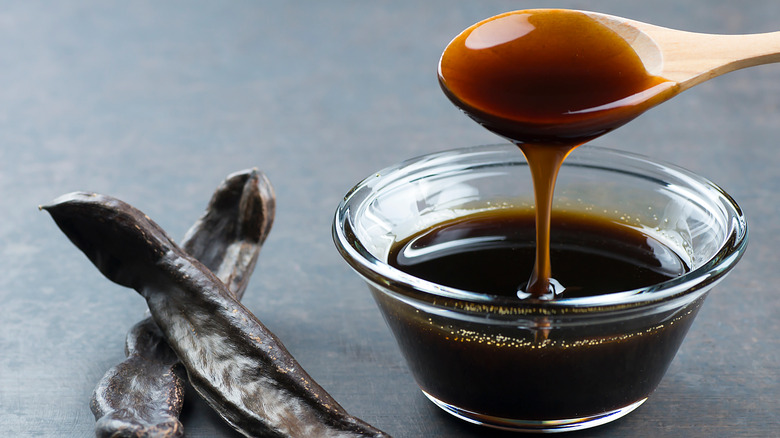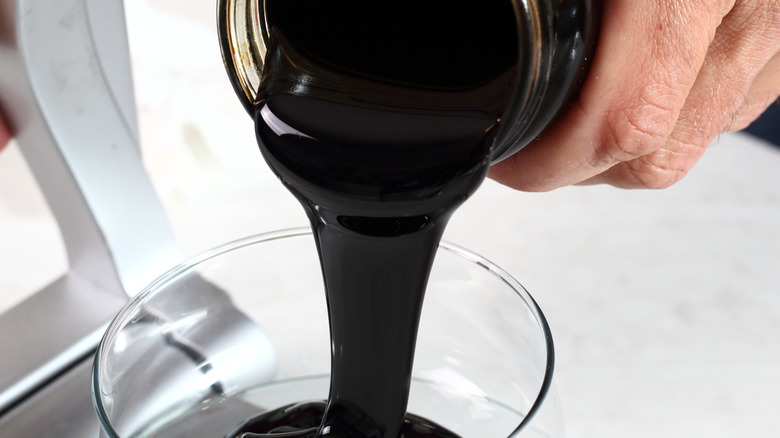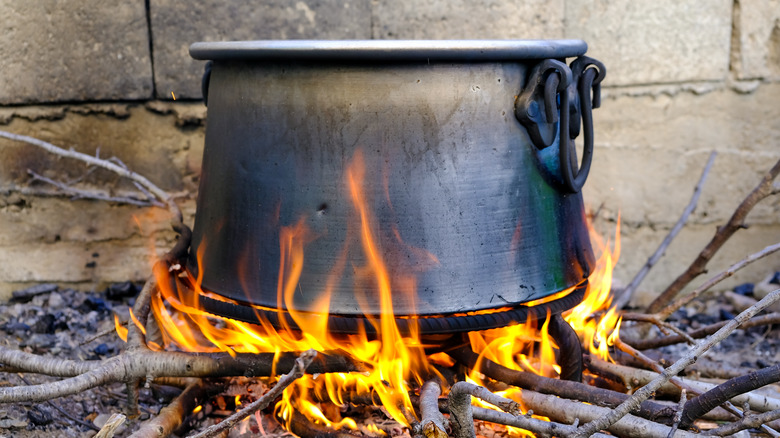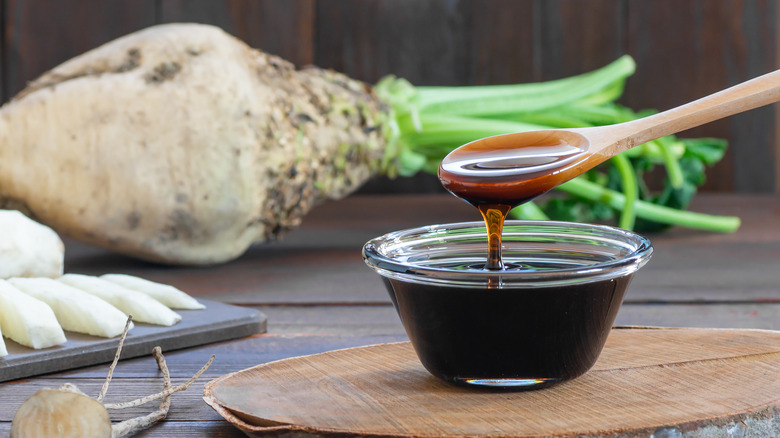What Is Molasses And What Does It Taste Like?
We may receive a commission on purchases made from links.
Sweet, sticky, syrupy, thick, brown, common, and yet often completely misunderstood, molasses is one of those things in life you likely take for granted, right up until the moment it hits you: You have no idea what molasses actually is. And you have no idea what it really tastes like either, right? You know it's sweet. Maybe honey-like? Or similar to brown sugar? Or does it taste like vanilla or maple?
The answer to all of those questions is ... sort of. Depending on the variety of molasses you choose, it will be, by varying degrees, sweet and smoky, vaguely reminiscent of honey, maple, and vanilla, not to mention ginger, and it is absolutely honey-like in its thick, sticky consistency (via The Kitchn). We'll talk about the taste of molasses in more detail below, but first to answer the more direct question: What is molasses?
Simply put, molasses is the syrup left over after sugar crystals are removed from boiling the liquid extracted from sugar cane, sugar beets or, in rarer cases, sorghum, or pomegranates, though Simply Recipes explains that sugar must be added to make pomegranate molasses. The three primary types of molasses are made by collecting the syrup after different stages of boiling and reduction, down to a thick syrup. Thus the sweetness in taste and the darkness in color.
What does molasses taste like?
There are three main types of molasses, and each has a slightly different flavor profile (via The Kitchn). Taken on the whole, though, the flavor of molasses can be described as a confluence of sweetness, smokiness, light bitterness, a touch of savory, and a hint of spice. It is ultimately a flavor unto itself, making its perfect description a task on par with that of defining the taste of anise, onion, or butterscotch, to name three disparate examples.
A better way to think of the taste of molasses could be to consider the many foodstuffs in which it plays a defining role, as you've likely eaten one of them. Molasses is often found flavoring things like gingerbread cookies, baked beans, and barbecue sauce (via Taste of Home). Think about the similarities running through the tastes of all those foods and you'll begin to appreciate what molasses tastes like.
The three types of molasses
Leaving aside the less common forms of this thick, lovely syrup, like mulberry molasses, there are three primary types of molasses. These are, according to The Kitchn, light molasses, dark molasses, and blackstrap molasses.
Light molasses is collected after sugar cane (or sugar beet) extract goes through its first boiling and sugar crystal removal process. It is lighter in color than the other varieties, and it is sweeter and less robust in terms of taste. Light molasses is commonly used in baking and in sauces.
Dark molasses is harvested after a second boiling of the sweet extract, thus the darker appearance (a result of more time cooking) and the thicker consistency (more water boiled off). Dark molasses is still sweet but not as sugary and cloying, and it has that distinct spiced profile that helps define gingerbread, among other foods.
Blackstrap molasses gets its name from the Dutch word stroop, meaning syrup (via Food Reference) and, of course, the fact that it's nearly black — "black syrup." This thick, dark, smoky, and only minimally sweet syrup is collected after the third and final boiling and reduction of that sweet, sugary extract we started with so many boiling sessions ago.
A brief history of molasses
The direct etymology of the term in English comes from the Portuguese (via Spruce Eats) word for molasses — melaço — though that term is itself derived from the Latin word mellaceum, which effectively means "honey-like" (via MasterClass).
While used in various regions of the world for thousands of years (via New World Encyclopedia), molasses did not come to be a major player in the global marketplace until the 17th century, when it became a valuable commodity often traded in exchange for slaves forcibly brought to the Americas from Africa. Molasses was shipped to America for use as a sweetener and to be made into rum, much of which was then shipped back east across the Atlantic ocean.
Until the later years of the 19th century, Spruce Eats explains molasses was the most common sweetener used in American cooking, though improvements in sugar refining would see that change in the 20th century. In the year 1919, a massive vat of boiling molasses exploded at the Purity Distilling Company of Boston, Massachusetts, sending millions of gallons of hot molasses surging from the factory and down city streets. 21 people were killed and many more injured.
Ironically, when cool, molasses does live up to the phrase "slow as molasses," as the thick syrup tends to pour painstakingly slowly, and never could have flooded streets fast enough to cause such death and suffering.
The surprising health benefits of molasses
Light and dark molasses are not all that healthy, and that's hardly a surprise, given that molasses is usually made from sugar cane (or sugar beets) and is basically just a sugar syrup. However, when it comes to that triple-boiled blackstrap molasses, you start to see some unexpected but impressive nutritional value, according to Healthline. Blackstrap molasses has a relatively low sugar content. It also has a decent concentration of several essential vitamins and minerals.
A single tablespoon of blackstrap molasses delivers 20% of your daily requirement for iron, it is packed with about half as much potassium as an average banana, and it has notable quantities of calcium, magnesium, selenium, and vitamin B6. And of course on top of the nutritional value of the thick, dark stuff, blackstrap molasses is a tasty ingredient as well. It is well-suited to use in sauces, as a glaze, in semi-sweet baked goods, and in many other types of foods.
When it comes to light molasses, there are about 15 grams of sugar per serving (via Very Well Fit), which is even more than you will find in many brands of maple syrup (via Healthline).




